Health Protection Agency (HPA) UK Novel Coronavirus Investigation Team. 2013. Evidence of person-to-person transmission within a family cluster of novel coronavirus infections, United Kingdom, February 2013. Euro Surveillance 18(11):20427.
Hijawi, B., M. Abdallat, A. Sayaydeh, S. Alqasrawi, A. Haddadin, N. Jaarour, S. Alsheikh, and T. Alsanouri. 2013. Novel coronavirus infections in Jordan, April 2012: epidemiological findings from a retrospective investigation. Eastern Mediterranean Health Journal 19 Suppl 1:S12-18.
Perera, R. A., P. Wang, M. R. Gomaa, R. El-Shesheny, A. Kandeil, O. Bagato, L. Y. Siu, M. M. Shehata, A. S. Kayed, Y. Moatasim, M. Li, L. L. Poon, Y. Guan, R. J. Webby, M. A. Ali, J. S. Peiris, and G. Kayali. 2013. Seroepidemiology for MERS coronavirus using microneutralisation and pseudoparticle virus neutralisation assays reveal a high prevalence of antibody in dromedary camels in Egypt, June 2013. Euro Surveillance 18(36):pii=20574.
Reusken, C. B., M. Ababneh, V. S. Raj, B. Meyer, A. Eljarah, S. Abutarbush, G. J. Godeke, T. M. Bestebroer, I. Zutt, M. A. Muller, B. J. Bosch, P. J. Rottier, A. D. Osterhaus, C. Drosten, B. L. Haagmans, and M. P. Koopmans. 2013. Middle East Respiratory Syndrome coronavirus (MERS-CoV) serology in major livestock species in an affected region in Jordan, June to September 2013. Euro Surveillance 18(50):20662.
WHO Mers-Cov Research Group. 2013. State of Knowledge and Data Gaps of Middle East Respiratory Syndrome Coronavirus (MERS-CoV) in Humans. PLoS Currents:Outbreaks DOI: 10.1371/currents.outbreaks.0bf719e352e7478f8ad85fa30127ddb8.
Dirk U. Pfeiffer20
Introduction
The past 20 years have seen a perceived and probably real increase in the number of viruses emerging that are pathogenic for animals and for both animals and humans. An important question is whether this pattern is indeed real or a consequence of improved diagnostic tools and surveillance. If it is indeed real, as it is generally believed to be, it represents a threat to humanity, and it is therefore important to understand the underlying causal mechanisms in order to be able to effectively predict and control, and ideally prevent, such emergence events. To be able to achieve, it is not only necessary to have good science, but an effective relationship between science and policy is required. To complicate matters further
_______________
20 Veterinary Epidemiology, Economics & Public Health Group, The Royal Veterinary College, London, United Kingdom.
both science and policy will need to have a global or regional rather than just a local or national perspective.
Context
Humankind has had a dominating influence on our global ecosystem for some time now, which is expressed in the notion that we are living in the age of the anthropocene (Crutzen, 2002; Ellis et al., 2013). So-called megatrends can be used to express current views of the likely future behavior and trajectory of humanity. The European Environment Agency published a global megatrends study that predicted, among a number of other trends, for the next 30 to 100 years an increasing scarcity of natural resources, increasing economic divergence, increasing urbanisation, and increasing risk of wild animal species extinction and biodiversity loss (Anonymous, 2011). These particular megatrends (as well as others not mentioned here) and their interactions will strongly influence viral emergence and associated policy responses. While a better understanding of the causal mechanisms of emergence is necessary, it has to be recognised that the general public is likely to attribute a higher priority to policy responses to risks other than the ones associated with diseases, which will therefore influence the relative prioritisation of policy makers. Since 2005, the World Economic Forum has commissioned an annual global risk mapping study. The results from 2014 (similar to previous years’ reports) demonstrate how much less significance people from around the world attribute to the risk of pandemic disease compared with the five most highly ranked risks: fiscal crises, unemployment, water crises, income disparity, and climate change (Figure A8-1) (Anonymous, 2014a).
Eco-social Changes
Accelerated economic development over the last 20 years has involved a large number of eco-social changes that affect the risk of viral emergence. Increasing urbanization is one of the key features of this development, and it has been predicted that by 2050 6.3 billion of the total human population of 9.3 billion will live in urban areas (Anonymous, 2012). Transport networks have become extremely effective, and as a consequence most locations around the world are within a 6–12-hour travel distance from the nearest city of 50,000 or more people (Anonymous, 2009b). The expansion of human habitat has resulted in a reduction of global forest cover, with 2.3 million sq km being lost against a gain of 0.8 between 2000 and 2012. The tropical climate domain has an increasing trend of 2101 sq km/year in annual forest loss (Hansen et al., 2013). This pattern is influenced by a number of factors, one of them being the increasing demand for food, in particular meat. The graph presented in Figure A8-2 shows a general global trend toward more intensive meat production. While this growth has been close to linear in Europe and North America between 1961 and 2012, China and
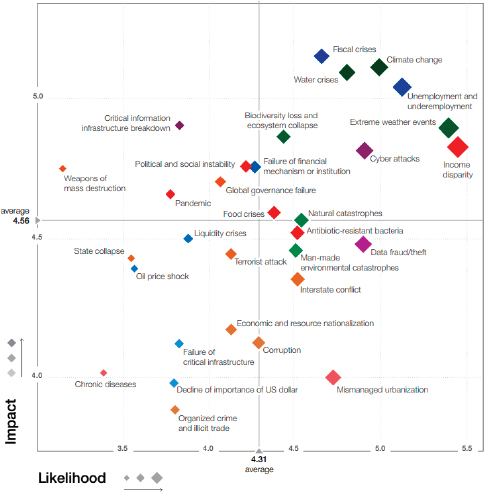
FIGURE A8-1 Perceived impact and likelihood of different risks based on a global risk perception survey, 2013–2014.
SOURCE: Anonymous, 2014a, from “Global Risks 2014,” World Economic Forum, Switzerland, 2014.
Southeast Asia have experienced a period of exponential growth resulting in the highest meat production density. This pattern is likely to continue with continuing economic development in Asian countries where human population density is already very high, but also in other regions of the world such as Africa and South America.
The need to increase food production intensity has resulted in initiatives such as the Singapore-Jilin Food Zone project. This includes setting up a 1,450 sq km area in China’s Jilin province that is free from foot-and-mouth disease and will be used for food production, including raising pigs, chickens, and cattle at high
density. A key objective of setting up this food production zone is to ensure a high food safety standard by introducing the most up-to-date food production and biosecurity methods. The consumers of the food produced in this zone will be primarily from China and Singapore.
A general global phenomenon has been that the value chains connecting the food producers with consumers, which were mainly local a century ago, in many cases have become globalised. An important driver for this development has been cost-effectiveness together with a demand for increased product variety and quality. An example for this situation is the sevenfold increase in the value of imports of pigs and pig meat products to China from other parts of the world between 2005 and 2011 as a consequence of increased demand for product quality combined with increased purchasing power of Chinese middle class consumers (see Figure A8-3). This indicates the speed at which economic development in one part of the world can lead to major changes in production intensity in other parts and shifts of global patterns of product flow.
Production chains also have become increasingly fragmented and therefore product quality control has become more challenging, as was demonstrated in the European Union during the E. coli O104:H4 outbreak in 2011 and the horse meat adulteration scandal in 2013 (Anonymous, 2014b; Appel et al., 2012). Attribution of negative or positive characteristics of food products in such fragmented
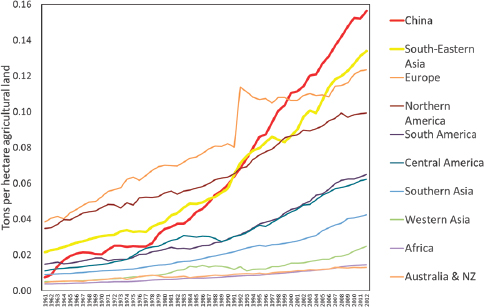
FIGURE A8-2 Temporal pattern of meat production intensity for different parts of the world between 1961 and 2012.
SOURCE: FAOSTAT database.
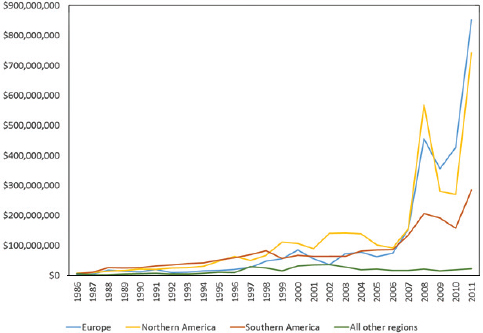
FIGURE A8-3 Temporal pattern of value (in US$) of imports of pigs and pig products to China from various regions of the world between 1986 and 2011.
SOURCE: FAOSTAT database.
production chains is almost impossible, thereby providing producers or other actors involved in the value chain with little incentive to improve product quality. The globalisation of value chains has resulted in trade networks that connect a large number of countries around the world. Ercsey-Ravasz et al. (2012) analysed the complexity of global agri-food trade, which revealed the connectedness between the 44 countries with the highest total food trade activity in 2007. The resulting network also shows the central role of countries such as The Netherlands, Denmark, Ireland, and Belgium in the agri-food trade context. This connectedness in food production chains is associated with benefits in terms of product variety and cost-effectiveness, but it also increases the risk of spread of contaminants or infectious pathogens. The mathematicians Erdõs and Rényi (1960) described the phenomenon, which was later named the connectivity avalanche. It relates to the connectivity between individual entities, called nodes. The underlying process starts with isolated nodes, then clusters consisting of pairs of nodes are formed, followed by clusters involving multiple nodes. The connectivity avalanche occurs at a particular point when adding further connections converts a pattern consisting of multiple clusters into a so-called giant highly connected component with only few isolated nodes remaining, and eventually results in a single connected network (Seeley, 2007). With respect to direct and indirect global connectivity
between humans and animals, we have probably reached a phase that is close to transition toward the connectivity avalanche. If that transition occurs, which is very likely, it will have serious implications for the risk of infectious pathogens.
The extent to which human activity dominates biomass production of the Earth’s biosphere has been quantified by Haberl et al. (2007). The results show that in the period 1998–2002 agriculture was responsible for 78 percent of human appropriation of net primary production. It also indicates that there are parts of the world such as in Africa, Russia, and Central Asia where there is potential for an increase in agricultural productivity. Krausmann et al. (2013) took these results further and emphasised the need to improve efficiency of pasture-associated production. The spatial disconnection between consumption and the environmental impact of production of biomass was examined for the year 2000 by Erb et al. (2009). They noted the interdependence and spatial separation of biomass production and consumption which leads to the development of complex socioecological interactions. This work has been taken further by Meyfroidt et al. (2013) who in the context of globalisation emphasized the influence of distant markets on land use changes, particularly through the growing urban consumer class in emerging markets.
There is now increasing recognition that natural ecosystems should be looked at as providing a service to human society, which means that economic values can be attributed to them (Costanza et al., 2011). Ecosystems vary in their characteristics, which includes the diversity of living organisms. They provide human society with various types of natural resources, regulate our environment, and supply us with cultural services (Anonymous, 2003).
Disease Emergence and Spread
The past 30 years have demonstrated the ability in particular of pathogenic viruses to move around the world at increasing speed. This has been facilitated by trade networks of live animals and their products, but probably primarily by human movement. The patterns of spread vary depending on the characteristics of the pathogen, livestock production system characteristics, socioeconomic factors, and the risk management measures put in place (Hui, 2006; Karesh et al., 2012; Plowright et al., 2008). As an example, foot-and-mouth disease virus is a livestock disease that has been present for a long time. It is nowadays only endemic in low- to middle-income countries, whereas most high-income countries are able to maintain freedom from infection. Other infections, such as bluetongue and Schmallenberg virus which involve an insect vector, change their spatial distribution depending on the season of the year. But there has been a trend for them to move further north, probably associated with climate change (Doceul et al., 2013; Koenraadt et al., 2014; Saegerman et al., 2008). Both viruses have recently emerged in northern Europe without it being possible to explain the source of introduction, and in the case of the Schmallenberg virus it was actually
newly detected. African swine fever virus used to be endemic only in Africa, apart from short incursions into the Caribbean, Brazil, and the Iberian Peninsula in the past and current long-term endemicity on the island of Sardinia. In 2007, it appeared in Georgia and has since spread across several Eastern European countries despite extensive control efforts. It is spread through direct or indirect contact between pigs or some tick vector species, and can become endemic in wild pig species (Costard et al., 2009). Highly pathogenic avian influenza virus (HPAIV) H5N1 emerged in China in 1996 and has since spread around Southeast Asia and parts of South Asia where it has become endemic in several countries. Incursions occurred into Africa and Europe, but resulted in endemicity only in Egypt. Wild waterfowl and poultry trade are the main mechanisms for long-distance spread, whereas local spread is influenced by the characteristics of the local poultry production system, in particular the density of ducks (Pfeiffer et al., 2011). Other examples of viral emergence are porcine reproductive and respiratory syndrome and porcine circoviral disease, which were first described in 1987 and 1997, respectively (Baekbo et al., 2012; Lunney et al., 2010). Both diseases are now present in the pig production systems of most countries around the world, causing significant losses particularly in intensive pig production (Rose et al., 2012; Rowland and Morrison, 2012). There are a variety of other zoonotic virus diseases that have emerged in the past 15 years from animal populations and caused disease in humans, including HPAIV H5N1, HPAIV H1N1, HPAIV H7N9, SARS, West Nile virus, and Nipah virus (Jones et al., 2013). Most of these events have been associated with intensification of production resulting in amplification of transmission within the relevant domestic animal species followed by spillover into humans (HPAIV H5N1, HPAIV H1N1, HPAIV H7N9). In some instances, the emergence has been due to changes of the interface between wild and domestic animals and humans (Nipah virus, West Nile virus, SARS). The pathogen’s ability to transmit among humans then determined its further spread, and here SARS and in particular HPAIV H1N1 were very effective.
Systems Perspective to Risk Assessment
The eco-social changes that have occurred particularly in the past 20 years have generated an environment that significantly enhances the ability for viral pathogens to change and spread very quickly around the world. Any attempt to assess the risks associated with such events needs to acknowledge the complexity of this global system. This requires an interdisciplinary approach, which is the background to the development of the One Health and EcoHealth approaches (Zinsstag, 2012). An example of the challenge represented by these complex systems is the emergence and continuing presence of HPAIV H5N1 in large parts of Asia. A key driver of the spread of the virus is human behaviour influenced by cultural and economic factors. Figure A8-4 shows the complexity of the resulting eco-social system, which is described in more detail in Pfeiffer et al. (2013). It
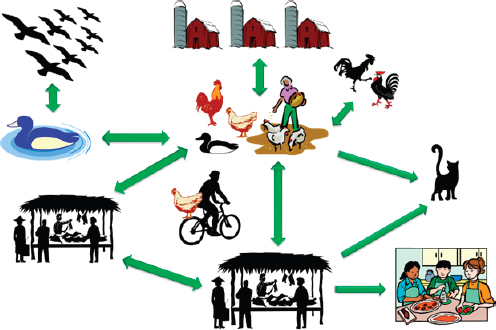
FIGURE A8-4 Eco-social system components influencing spread of HPAIV H5N1 in parts of Asia.
centres around small- to medium-size poultry producers keeping chickens as well as domestic waterfowl. They are connected with each other and with consumers through live bird trade networks that often also cross national boundaries. The density of birds in these populations and intensity of the trade varies in space and time, influenced by the variation in demand for and therefore the price of poultry meat. There are links between this production system and wild waterfowl populations, fighting cock activity, and large-scale industrial poultry production that will also influence spread. The risk management of HPAIV H5N1 in these populations is based on disease outbreak detection, followed by extensive poultry culling and potentially large-scale vaccination. These control methods are often not entirely supported by the stakeholders in the system, which is probably one reason for the reoccurrence of infection. It therefore needs to be accepted that with these control tools it is currently impossible to eliminate infection from these systems. Only Thailand has managed to achieve apparent freedom from infection in domestic poultry since 2008, without ever using vaccination. Most countries surrounding Thailand, and also Bangladesh, Indonesia, and China, continue to report outbreaks, with several of them applying large-scale poultry vaccination campaigns. It is notable that while HPAIV H5N1 occasionally spreads from its epicentre in Southeast Asia and East Asia to Europe and Africa, of those long-distance moves the virus only managed to become endemic in Egypt. It was never reported from the Philippines, Australia/New Zealand, or the Americas. This local
and global pattern of HPAIV H5N1 demonstrates the importance of the features of the local eco-social system in relation to the ability of the virus to become endemic. The particular practice of small- to medium-scale poultry producers engaging in live poultry trade together with presence of ducks appears to play a key role in maintenance of HPAIV H5N1. Increased demand from urban consumers has resulted in intensification of this type of trade activity, and thereby is likely to have provided an environment that supports virus maintenance as well as evolution, as reflected in the continuing emergence of new HPAIV H5N1 clades and variants of avian influenza.
From Risk Assessment to Management
Risk assessment of disease threats provides a synthesis of scientific evidence that is then used to develop appropriate risk management. The emphasis within that context has been on biomedical science, and socioeconomic drivers of disease risk most of the time have been ignored. This means policy makers and scientists tend to focus their efforts on coming up with a technical “tool” that allows mitigating the risk, ideally through intervention using a treatment or vaccine. Within human health the importance of behaviour change as a social tool has been recognised since the emergence of HIV/AIDS. It is now clear that effective management of the disease threats associated with eco-social changes needs to be based on a systems perspective. Coker et al. (2011) presented a conceptual framework for such an approach within a One Health context. Figure A8-5 shows
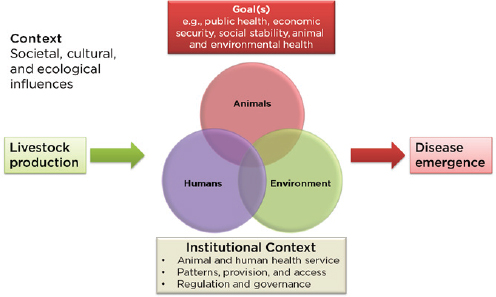
its key elements for the example of livestock production where it emphasizes the importance of the institutional and the wider societal context. These two factors will influence the goals that different stakeholders associate with the risk of disease emergence, and these goals are likely to vary among stakeholders and may even contradict between some of them.
Taking the risk assessment to the logical next step, the management of the risk, Millstone et al. (2004) characterised three different models linking science with risk management: the technocratic, the decisionistic, and the transparent models for policy development. The key difference is that the technocratic approach focuses primarily on science as the primary and theoretically only source of information for policy development. This method has been used widely, or at least was considered to be the basis of so-called science-based policy development. With the decisionistic approach, social and economic considerations are taken into account when policy makers decide on the risk management policy, but neither prior to nor during the risk assessment. This is the currently most widely used approach, and it could be called science-led (as distinct from science-based) decision making. Both approaches do not adequately take account of the wider socioeconomic context and the goals and therefore the motivations of key stakeholders that are all recognised as having significant influence on the effectiveness of any risk management policy. The transparent approach to policy development described by Millstone et al. (2004) addresses this shortcoming. Here, prior to starting the risk assessment, a risk assessment policy is developed that takes the institutional and wider societal context into account. The weaknesses of the currently used technocratic and decisionistic approaches to decision making about health risks have also been pointed out in a report produced by the Committee on Improving Risk Analysis Approaches Used by the U.S. EPA (Anonymous, 2009a).
Pfeiffer (2014) reviewed the role of science in decision making for animal and zoonotic diseases in the context of disease emergence and eco-social changes that have occurred in the past 30 years. He suggests the need to adopt an interdisciplinary approach to the science and to embed the risk assessment within a risk governance framework, such as developed by the International Risk Governance Council (Anonymous, 2008). Figure A8-6 shows the components of this framework, which add a framing and evaluation component to the risk analysis frameworks, defined by the World Organisation for Animal Health (Anonymous, 2013b) and Codex Alimentarius (Anonymous, 2013a). Both these components formalise the need to reflect the wider system context, particularly in relation to social and economic factors, and therefore the engagement with relevant stakeholders. Such an approach to policy development will foster an interdisciplinary approach to the science as well as the resulting decision making.
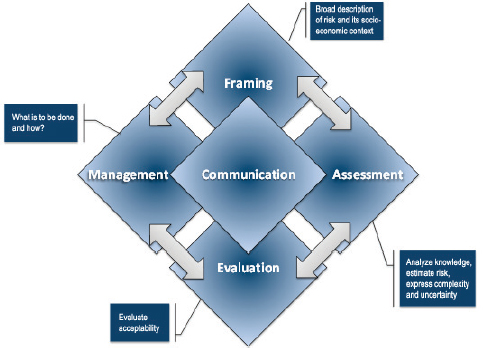
FIGURE A8-6 Components of the risk governance framework.
SOURCE: Adapted from Anonymous, 2008.
Conclusions
Eco-social changes that have occurred particularly rapidly and on a global scale in parallel with global economic development in the past 20 years have included significant changes to the animal–human interface. This has had the important side effect of providing a highly efficient environment for emergence of viral pathogens. Human interventions used to have a local, national, and sometimes regional effect, whereas now, this effect is often global. Complex and dynamic relationships, including interactions and feedback effects between natural and man-made phenomena, drive the behaviour of the global ecosystem. Scientific approaches need to be adapted to this situation, in particular by embracing systems thinking and interdisciplinary research approaches. While this includes linking animal with human health, it is as important to include the environmental and social sciences. But it is important that the required science is purpose driven, ideally informed by risk assessment, and, for it to be useful, it needs to be embedded in risk governance frameworks that explicitly take account of the societal context within which risks occur and are to be managed.
References
Anonymous. 2003. Ecosystems and human well-being—A framework for assessment. Millennium Ecosystem Evaluation Board. http://pdf.wri.org/ecosystems_human_wellbeing.pdf (accessed October 26, 2014).
Anonymous. 2008. An introduction to the IRGC risk governance framework. Geneva, Switzerland: International Risk Governance Council.
Anonymous. 2009. Science and decisions: Advancing risk assessment. Washington, DC: The National Academies Press.
Anonymous. 2009. World Development Report 2009: Reshaping economic geography. Washington, DC: The International Bank for Reconstruction and Development/The World Bank.
Anonymous. 2011. The European environment—–State and outlook 2010: Assessment of global megatrends. Copenhagen, Denmark: European Environment Agency.
Anonymous. 2012. World urbanization prospects—The 2011 revision. New York: United Nations Department of Economic and Social Affairs/Population Division.
Anonymous. 2013a. Codex Alimentarius Commission—Procedural Manual. Rome, Italy: World Health Organization/Food and Agriculture Organization of the United Nations.
Anonymous. 2013b. Terrestrial animal health code. 22nd ed. Paris, France: World Organisation for Animal Health.
Anonymous. 2014a. Global risks 2014. Geneva, Switzerland: World Economic Forum.
Anonymous. 2014b. Horsemeat in “beef” products: European Commission summarises progress. Veterinary Record 174(11):264.
Appel, B., G.-F. Böl, M. Greiner, M. Lahrssen-Wiederholt, and A. Hensel. 2012. EHEC outbreak 2011—Investigation of the outbreak along the food chain. Berlin, Germany: Federal Institute for Risk Assessment.
Baekbo, P., C. S. Kristensen, and L. E. Larsen. 2012. Porcine circovirus diseases: A review of PMWS. Transboundary and Emerging Diseases 59(Suppl 1):60-67.
Coker, R., J. Rushton, S. Mounier-Jack, E. Karimuribo, P. Lutumba, D. Kambarage, D. U. Pfeiffer, K. Stark, and M. Rweyemamu. 2011. Towards a conceptual framework to support One-Health research for policy on emerging zoonoses. Lancet Infectious Diseases 11(4):326-331.
Costanza, R., I. Kubiszewski, D. Ervin, R. Bluffstone, J. Boyd, D. Brown, H. Chang, V. Dujon, E. Granek, S. Polasky, V. Shandas, and A. Yeakley. 2011. Valuing ecological systems and services. F1000 Biology Reports 3(14):1-6.
Costard, S., B. Wieland, G. W. de, F. Jori, R. Rowlands, W. Vosloo, F. Roger, D. U. Pfeiffer, and L. K. Dixon. 2009. African swine fever: How can global spread be prevented? Philosophical Transactions of the Royal Society B: Biological Sciences 364(1530):2683-2696.
Crutzen, P. J. 2002. Geology of mankind. Nature 415(6867):23.
Doceul, V., E. Lara, C. Sailleau, G. Belbis, J. Richardson, E. Breard, C. Viarouge, M. Dominguez, P. Hendrikx, D. Calavas, A. Desprat, J. Languille, L. Comtet, P. Pourquier, J. F. Eleouet, B. Delmas, P. Marianneau, D. Vitour, and S. Zientara. 2013. Epidemiology, molecular virology and diagnostics of Schmallenberg virus, an emerging orthobunyavirus in Europe. Veterinary Research 44:31.
Ellis, E. C., J. O. Kaplan, D. Q. Fuller, S. Vavrus, K. Klein Goldewijk, and P. H. Verburg. 2013. Used planet: A global history. Proceedings of the National Academy of Sciences of the United States of America 110(20):7978-7985.
Erb, K.-H., F. Krausmann, W. Lucht, and H. Haberl. 2009. Embodied HANPP: Mapping the spatial disconnect between global biomass production and consumption. Ecological Economics 69(2):328-334.
Ercsey-Ravasz, M., Z. Toroczkai, Z. Lakner, and J. Baranyi. 2012. Complexity of the international agro-food trade network and its impact on food safety. PLoS ONE 7(5):e37810.
Erdõs, P., and A. Rényi. 1960. On the evolution of random graphs. Magyar Tudományos Akadémia Matematikai Kutató Intézet Közleménye 5:17-61.
Haberl, H., K. H. Erb, F. Krausmann, V. Gaube, A. Bondeau, C. Plutzar, S. Gingrich, W. Lucht, and M. Fischer-Kowalski. 2007. Quantifying and mapping the human appropriation of net primary production in Earth’s terrestrial ecosystems. Proceedings of the National Academy of Sciences of the United States of America 104(31):12942-12947.
Hansen, M. C., P. V. Potapov, R. Moore, M. Hancher, S. A. Turubanova, A. Tyukavina, D. Thau, S. V. Stehman, S. J. Goetz, T. R. Loveland, A. Kommareddy, A. Egorov, L. Chini, C. O. Justice, and J. R. Townshend. 2013. High-resolution global maps of 21st-century forest cover change. Science 342(6160):850-853.
Hui, E. K. 2006. Reasons for the increase in emerging and re-emerging viral infectious diseases. Microbes and Infection 8(3):905-916.
Jones, B. A., D. Grace, R. Kock, S. Alonso, J. Rushton, M. Y. Said, D. McKeever, F. Mutua, J. Young, J. McDermott, and D. U. Pfeiffer. 2013. Zoonosis emergence linked to agricultural intensification and environmental change. Proceedings of the National Academy of Sciences of the United States of America 110(21):8399-8404.
Karesh, W. B., A. Dobson, J. O. Lloyd-Smith, J. Lubroth, M. A. Dixon, M. Bennett, S. Aldrich, T. Harrington, P. Formenty, E. H. Loh, C. C. Machalaba, M. J. Thomas, and D. L. Heymann. 2012. Ecology of zoonoses: Natural and unnatural histories. Lancet 380(9857):1936-1945.
Koenraadt, C. J., T. Balenghien, S. Carpenter, E. Ducheyne, A. R. Elbers, M. Fife, C. Garros, A. Ibanez-Justicia, H. Kampen, R. J. Kormelink, B. Losson, W. H. van der Poel, N. De Regge, P. A. van Rijn, C. Sanders, F. Schaffner, M. M. Sloet van Oldruitenborgh-Oosterbaan, W. Takken, D. Werner, and F. Seelig. 2014. Bluetongue, Schmallenberg - what is next? Culicoides-borne viral diseases in the 21st Century. BMC Veterinary Research 10:77.
Krausmann, F., K. H. Erb, S. Gingrich, H. Haberl, A. Bondeau, V. Gaube, C. Lauk, C. Plutzar, and T. D. Searchinger. 2013. Global human appropriation of net primary production doubled in the 20th century. Proceedings of the National Academy of Sciences of the United States of America 110(25):10324-10329.
Lunney, J. K., D. A. Benfield, and R. R. Rowland. 2010. Porcine reproductive and respiratory syndrome virus: An update on an emerging and re-emerging viral disease of swine. Virus Research 154(1-2):1-6.
Meyfroidt, P., E. F. Lambin, K.-H. Erb, and T. W. Hertel. 2013. Globalization of land use: Distant drivers of land change and geographic displacement of land use. Current Opinion in Environmental Sustainability 5(5):438-444.
Millstone, E., P. van Zwanenberg, C. Marris, L. Levidow, and H. Torgerson. 2004. Science in trade disputes related to potential risks: Comparative case studies. Seville, Spain: European Commission Joint Research Centre—Institute for Prospective Technological Studies.
Pfeiffer, D. U. 2014. From risk analysis to risk governance—Adapting to an ever more complex future. Veterinaria Italiana 50(3):169-176.
Pfeiffer, D. U., M. J. Otte, D. Roland-Holst, K. Inui, N. Tung, and D. Zilberman. 2011. Implications of global and regional patterns of highly pathogenic avian influenza virus H5N1 clades for risk management. Veterinary Journal 190:309-316.
Pfeiffer, D. U., M. J. Otte, D. Roland-Holst, and D. Zilberman. 2013. A One Health perspective on HPAI H5N1 in the Greater Mekong sub-region. Comparative Immunology Microbiology and Infectious Diseases 36(3):309-319.
Plowright, R. K., S. H. Sokolow, M. E. Gorman, P. Daszak, and J. E. Foley. 2008. Causal inference in disease ecology: Investigating ecological drivers of disease emergence. Frontiers in Ecology and the Environment 6(8):420-429.
Rose, N., T. Opriessnig, B. Grasland, and A. Jestin. 2012. Epidemiology and transmission of porcine circovirus type 2 (PCV2). Virus Research 164(1-2):78-89.
Rowland, R. R. R., and R. B. Morrison. 2012. Challenges and opportunities for the control and elimination of porcine reproductive and respiratory syndrome virus. Transboundary and Emerging Diseases 59:55-59.













